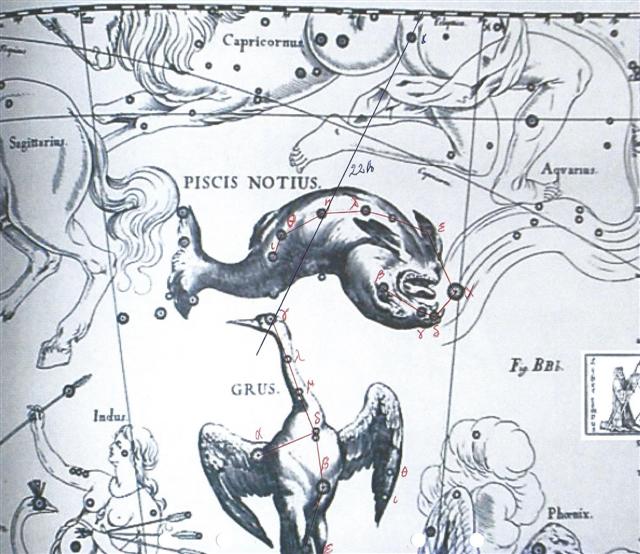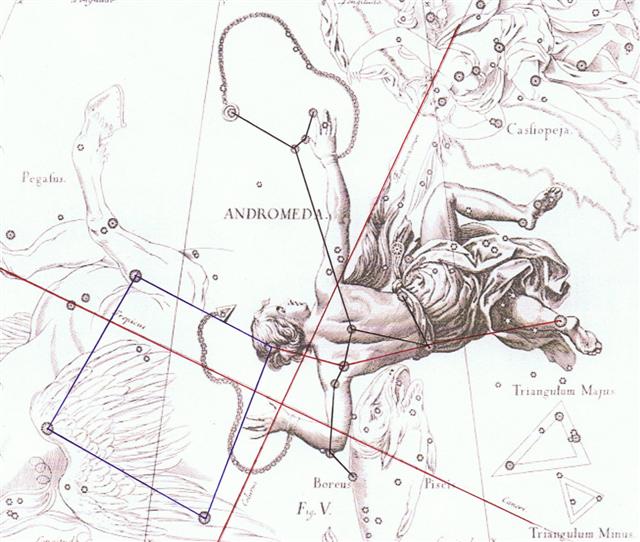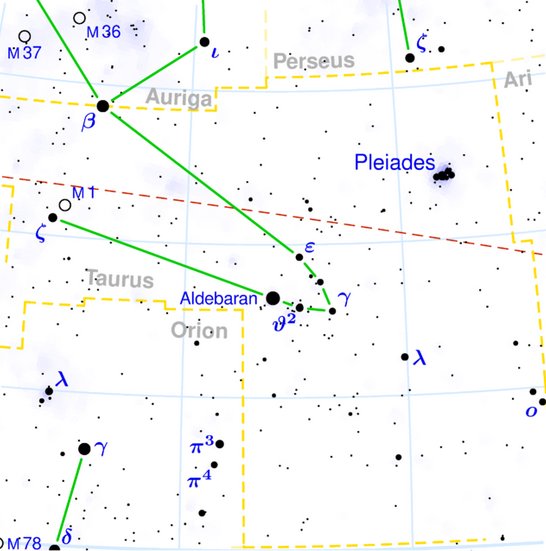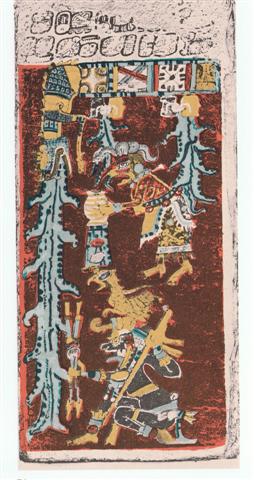From
the midnight
culmination of
Castor there were 8
days to heliacal Fomalhaut:

 |
 |
 |
 |
 |
| Gb5-29 |
Gb6-1 |
Gb6-2 (384) |
Gb6-3 |
Gb6-4 (157) |
| SOLSTICE |
DECEMBER 22 |
23 |
CHRISTMAS EVE |
25 (359) |
| β/172 Lac. (339.2), 4/1100 Lac. (339.4), π Aquarii (339.5)
Castor
|
δ Tucanae (340.1), ρ Cephei (340.2), ν Gruis (340.3), ζ Aquarii, δ Gruis (340.4), 5/1100 Lac. (340.7), σ Aquarii, 6/650 Lac. (340.9 Procyon
|
υ Oct. (341.0), α/91 Lac. (341.1), Homan, β Piscis Austrini (341.2), ν Tucanae (341.5), υ Aquarii (341.9) |
η Aquarii (342.1), σ Gruis (342.4), Situla (342.7) |
ε Piscis Austrini (343.5), ο Pegasi, β Gruis (343.8) |
| Terminalia |
February 24 |
25 (421) |
26 |
27 (58) |
| 'January 27 (392) |
28 |
29 |
30 |
31 |
 |
 |
 |
 |
 |
 |
|
Gb6-5 |
Gb6-6 |
Gb6-7
(160) |
Gb6-8 |
Gb6-9 |
Gb6-10
(392) |
|
DECEMBER 26 |
27 |
28 |
29 |
30
(364) |
31 |
|
ρ Gruis
(344.0),
Matar
(344.2), η
Gruis
(344.6) |
λ
Pegasi
(345.0),
ξ
Pegasi
(345.1),
ε
Gruis
(345.3),
τ Aquarii
(345.7), ξ
Oct.
(345.8), μ
Pegasi
(345.9) |
ι
Cephei
(346.0),
λ
Aquarii,
γ
Piscis
Austrini,
σ
Pegasi
(346.5) |
Scheat
Aquarii
(347.0),
ρ
Pegasi
(347.2),
δ
Piscis
Austrini
(347.4),
Fomalhaut,
τ
Gruis
(347.8) |
Fum
al
Samakah
(348.3),
ζ
Gruis
(348.5),
ο
Andromedae
(348.9) |
Al
Fargh
al
Mukdim-24
/
Purva
Bhādrapadā-26
/
House-13 |
|
Scheat
Pegasi,
π
Piscis
Austrini
(349.3),
κ
Gruis
(349.4),
MARKAB
PEGASI
(349.5) |
|
February
28
|
March
1 |
2 |
3 |
4
(428) |
5
(64) |
|
'February
1 |
2 |
3 |
4
(400) |
5
(36) |
6 |
And
then there were
an
additional 2 days to
the Fore
Spout (the
24th Arab
station), to
the 26th
Hindu
station, to the 13th
Chinese
station.
The Rear
Spout, where
the Pegasus
Square
ended at the
back side of
the head of
Andromedae, came
after another 16
days (i.e.
26 days
after the
culmination
of Castor):

 |
 |
 |
 |
 |
 |
|
Gb6-11
(393) |
Gb6-12
(165) |
Gb6-13 |
Gb6-14 |
Gb6-15 |
Gb6-16 |
|
JANUARY
1 |
2 |
3 |
4 |
5 |
6
(371) |
|
23h
(350.0) |
Simmah
(351.7) |
φ
Aquarii
(352.0),
ψ
Aquarii
(352.4),
χ
Aquarii
(352.6),
γ
Tucanae,
φ
Gruis
(352.8) |
ο
Cephei
(353.3),
Kerb
(353.6) |
κ
Piscium
(354.2),
θ
Piscium
(354.4),
υ
Pegasi
(354.9) |
ο
Gruis, Snowball
Nebula
(355.0),
τ
Oct.
(255.3) |
|
υ, θ
Gruis
(350.0),
π
Cephei
(350.6),
ι
Gruis
(350.9) |
|
March
6
(430) |
7 |
8 |
9 |
10 |
11
(70) |
|
'February
7 |
8 |
9
(40) |
10 |
11 |
12
(408) |
 |
 |
 |
|
Gb6-17 |
Gb6-18
(400) |
Gb6-19
(172) |
|
JANUARY
7
(372) |
8 |
9 |
|
no
star
listed
(356) |
ι
Phoenicis
(357.3),
ι
Piscium
(357.4),
λ
Andromedae
(357.9) |
λ
Piscium
(358.0),
Manus
Catenata
(358.1),
Alrai,
θ
Phoenicis
(358.4),
κ
Andromedae
(358.7) |
|
March
12
(436) |
13
(72) |
3-14 |
|
'February
13 |
2-14 |
15
(46) |
...
Februa,
also
Februatio,
was the
Roman
festival of
ritual
purification,
later
incorporated
into
Lupercalia.
The
festival,
which is
basically
one of
Spring
washing or
cleaning
(associated
also with
the
raininess of
this time of
year), is
old and
possibly of
Sabine
origin.
According to
Ovid,
Februare
as a Latin
word which
refers to
means of
purification
(particularly
with washing
or water)
derives from
an earlier
Etruscan
word
referring to
purging.
The Roman
month
Februarius
('of
Februa',
whence the
English
February) is
named for
the
Februa/Februatio
festival,
which
occurred on
the 13th to
15th days of
this Roman
month
...
 |
 |
 |
 |
 |
| Gb6-20 |
21 |
22 |
23 |
24 (177) |
|
JANUARY 10 |
11 |
12 |
13 (378) |
14 |
| ω Aquarii (359.2), 78 Pegasi (359.5) |
ψ Andromedae (360.1), σ Phoenicis (360.4) |
γ¹ Oct. (361.4), φ Pegasi (361.7) |
Dzaneb (362.4), γ² Oct. (362.8) |
η Tucanae (363.0), ψ Pegasi (363.1), 32 Piscium (363.2), π Phoenicis (363.4), ε Tucanae (363.6), τ Phoenicis (363.9) |
|
March 15 |
16 (440) |
17 |
18 |
19 (78) |
|
'February
16 |
17 (413) |
18 |
19 |
20 (51) |
 |
 |
 |
 |
| Gb6-25 |
Gb6-26 (408) |
Gb6-27 |
Gb6-28 (181) |
|
JANUARY 15 (*300) |
16 |
17 |
18 (383) |
| θ Oct. (364.9) |
Al Fargh al Thāni-25 |
Uttara Bhādrapadā-27 / Wall-14 |
χ Pegasi (2.1), θ Andromedae (2.7) |
| 0h (365.25) |
| Caph, SIRRAH (0.5), ε Phoenicis, γ³ Oct. (0.8) |
ο Oct. (1.3), ALGENIB PEGASI (1.8) |
|
March 20 (444) |
0h |
22 |
23 (82) |
|
'February
21 (52) |
22 |
Terminalia |
24 (420) |
At the
time of
the
Hyades
Gate,
when the
head of
the Bull was
at 0h,
the Rear
Spout had
been
the day
after
day 300
(JANUARY
15)
counted
from the
March
equinox,
and the
2nd
Spout
may have
delivered
'fresh
water
which
brought
life
back' (aqua
vitae):
... The
cord is
decorated
with
small
white
cowries,
not only
a sign
of
chieftainship
but by
name,
buli
leka,
a
continuation
of the
metaphor
of birth
-
buli,
'to
form',
refers
in
Fijian
procreation
theory
to the
conceptual
acception
of the
male in
the body
of the
woman.
The
sacrificed
child of
the
people
will
thus
give
birth to
the
chief.
But only
after
the
chief,
ferocious
outside
cannibal
who
consumes
the
cannibalized
victim,
has
himself
been
sacrificed
by it.
For when
the
ruler
drinks
the
sacred
offering,
he is in
the
state of
intoxication
Fijians
call
'dead
from' (mateni)
or 'dead
from
kava'
(mate
ni
yaqona),
to
recover
from
which is
explicitly
'to
live' (bula). This
accounts
for the
second
cup the
chief is
alone
accorded,
the cup
of fresh
water.
The god
is
immediately
revived,
brought
again to
life -
in a
transformed
state
...


Counted
by the
Moon -
and with her
cycle
beginnning
not at
0h but
80 days
earlier
- it had
been
day 380
(= 19 * 20).
...
The
Gilbert
Islanders
are
Polynesians,
having
emigrated,
according
to their
traditions,
from
Upolu,
Samoa,
which
they
look
upon as
te
buto
(Maori
pito),
the
Navel of
the
World.
They
never
counted
the
nights
of the
Moon
beyond
the
twentieth,
so far
as
Grimble
was able
to
ascertain,
and in
the
vagueness
of their
lunar
calendar
bore no
resemblance
to their
Micronesian
neighbors
of the
Carolines
...
The
old
Sun year
and the
old Moon
cycle
ended in
a
'Flood'
which
washed
them
away:

... When
it was
evident
that the
years
lay
ready to
burst
into
life,
everyone
took
hold of
them, so
that
once
more
would
start
forth -
once
again -
another
(period
of)
fifty-two
years.
Then
(the two
cycles)
might
proceed
to reach
one
hundred
and four
years.
It was
called
'One
Age'
when
twice
they had
made the
round,
when
twice
the
times of
binding
the
years
had come
together. Behold
what was
done
when the
years
were
bound -
when was
reached
the time
when
they
were to
draw the
new
fire,
when now
its
count
was
accomplished.
First
they put
out
fires
everywhere
in the
country
round.
And the
statues,
hewn in
either
wood or
stone,
kept in
each
man's
home and
regarded
as gods,
were all
cast
into the
water
...
Searching
for the
beginning
of the
old Moon
cycle we
could
try to count
380
glyphs
back in
the text
(from
Gb6-25)
and
reach
glyph 27
(because
407 -
380 = 27):
 |
 |
 |
377 |
| Ga1-27 |
Ga1-28 |
Ga1-29 |
| DECEMBER 31 |
JANUARY 1 (366) |
2 |
|
Al
Fargh
al
Mukdim-24
/
Purva
Bhādrapadā-26
/
House-13 |
23h
(350.0) |
Simmah
(351.7) |
|
Scheat
Pegasi,
π
Piscis
Austrini
(349.3),
κ
Gruis
(349.4),
MARKAB
PEGASI
(349.5) |
υ, θ
Gruis
(350.0),
π
Cephei
(350.6),
ι
Gruis
(350.9) |
|
March
5
(64) |
6 |
7 |
|
'February
6
(37) |
7 |
8 |
 |
 |
 |
 |
| Gb6-25 |
Gb6-26 (408) |
Gb6-27 |
Gb6-28 (181) |
|
JANUARY 15 (*300) |
16 |
17 |
18 (383) |
| θ Oct. (364.9) |
Al Fargh al Thāni-25 |
Uttara Bhādrapadā-27 / Wall-14 |
χ Pegasi (2.1), θ Andromedae (2.7) |
| 0h (365.25) |
| Caph, SIRRAH (0.5), ε Phoenicis, γ³ Oct. (0.8) |
ο Oct. (1.3), ALGENIB PEGASI (1.8) |
|
March 20 (444) |
0h |
22 |
23 (82) |
|
'February
21 (52) |
22 |
Terminalia |
24 (420) |
| 88 |
 |
 |
 |
| Ga1-27 |
Ga1-28 |
Ga1-29 |
| APRIL 17 |
18 (108) |
19 |
| 6h (91.3) |
ξ Orionis (92.5) |
Al Han'ah-4 / Maru-sha-pu-u-mash-mashu-8 |
| ν Orionis (91.4), θ Columbae (91.5), π Columbae (91.6) |
TEJAT PRIOR (93.4), γ Monocerotis (93.5), κ Aurigae (93.6), κ Columbae (93.8) |
| June 20 |
solstice |
22 (173) |
| 'May 24 (*64) |
25 |
26 (146 = 2 * 73) |
 |
90 + 290 |
 |
90 |
 |
| Ga1-29 |
Gb6-28 |
Ga1-29 |
91
days
is a
quarter
of a
year
and
the
glyph
texts
seems
to
say
that
at
the
June
solstice
the
quarter
beginning
at
the
March
equinox
was
expiring.
And
after
another
quarter
the
Sun
would reach
Raven
and
the
September
equinox.

 |
 |
 |
 |
88 |
 |
 |
 |
|
Gb6-25 |
Gb6-26 (408) |
Gb6-27 (*1) |
Gb6-28 (181) |
Ga1-27 |
Ga1-28 |
Ga1-29 |
|
JAN
15 |
*301 = *408
- *107 |
17 |
18 (383) |
APRIL 17 |
18 (108) |
19 |
|
θ Oct.
(364.9) |
Al
Fargh al
Thāni-25 |
Uttara Bhādrapadā-27
/
Wall-14 |
χ Pegasi (2.1),
θ Andromedae
(2.7) |
6h (91.3)
|
ξ Orionis (92.5) |
Al Han'ah-4 /
Maru-sha-pu-u-mash-mashu-8 |
|
Caph,
SIRRAH
(0.5), ε
Phoenicis,
γ³ Oct.
(0.8) |
ο Oct.
(1.3),
ALGENIB PEGASI
(1.8)
|
ν Orionis
(91.4), θ
Columbae (91.5),
π Columbae
(91.6) |
TEJAT PRIOR
(93.4), γ
Monocerotis
(93.5), κ
Aurigae (93.6),
κ Columbae
(93.8) |
|
March 20 |
Equinox (80) |
22 |
23 |
June 20 |
Solstice |
22 (173) |
|
'February 21 |
22 (53) |
Terminalia |
24 (*340) |
'May 24 (*64) |
25 |
26 (146 = 2 *
73) |
|
90 |
 |
 |
|
Ga5-10 (120) |
Ga5-11 |
|
JULY 19
(200) |
20 (*121) |
|
Pálida (184.6),
Megrez (184.9) |
Hasta-13 /
Chariot-28 |
|
GIENAH
(185.1), ε
Muscae (185.2),
ζ Crucis
(185.4), Zaniah
(185.9) |
|
September 21 |
Equinox (265) |
|
'August 25 (237) |
26 (*158) |

|






















